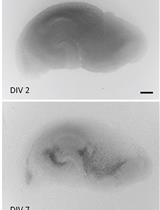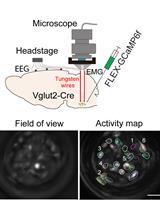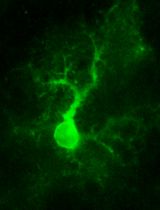- EN - English
- CN - 中文
Construction of Large Cranial Windows With Nanosheet and Light-Curable Resin for Long-term Two-Photon Imaging in Mice
利用纳米膜与光固化树脂构建大面积颅窗以实现小鼠长期双光子成像
(*contributed equally to this work) 发布: 2025年07月05日第15卷第13期 DOI: 10.21769/BioProtoc.5373 浏览次数: 1937
评审: Miao HeAnik TuladharAnonymous reviewer(s)

相关实验方案

利用基于 FRET 的 SuperClomeleon 传感器监测器官型海马切片中细胞内氯离子水平变化
Sam de Kater [...] Corette J. Wierenga
2025年03月05日 2657 阅读
Abstract
In vivo two-photon imaging of the mouse brain is essential for understanding brain function in relation to neural structure; however, its application is limited by the size and mechanical stability of conventional cranial windows. Here, we present the procedure of a large-scale cranial window technique based on the nanosheet incorporated into light-curable resin (NIRE) method. This approach utilizes a biocompatible polyethylene-oxide-coated CYTOP (PEO-CYTOP) nanosheet combined with light-curable resin, allowing the window to conform to the brain’s curved surface. The protocol enables long-term, high-resolution, and multiscale imaging—from subcellular structures to large neuronal populations—in awake mice over several months.
Key features
• This protocol establishes large-scale cranial windows by combining a flexible, biocompatible PEO-CYTOP nanosheet with light-curable resin.
• The large-scale cranial window provides long-term optical transparency and mechanical stability, enabling chronic in vivo imaging with minimal motion artifacts.
• This approach facilitates multiscale two-photon imaging—from subcellular structures to large-scale neural networks—in awake mice.
Keywords: Cranial window (颅窗)Background
Understanding complex brain functions such as neuroplasticity, learning, and disease progression requires long-term, high-resolution in vivo imaging of the mouse brain. Conventional cranial window techniques employing glass coverslips are often limited by small imaging fields [1,2]. To overcome this limitation, cranial windows made of curved transparent materials [3–5] have been developed to enable large-scale imaging. However, these windows rely on pre-molded materials and their shape is fixed, posing a risk of compressing the brain surface. Previously, we proposed the large-scale cranial window using a PEO-CYTOP nanosheet [6,7], which offers several advantageous properties, including strong adhesion, flexibility, and optical transparency [8–10]. This cranial window using PEO-CYTOP nanosheet enables in vivo two-photon imaging with a broad field of view and high spatial resolution. However, it does not adequately suppress motion artifacts in awake animals and remains too fragile for long-term imaging due to intracranial pressure fluctuations and mechanical stress from animal behavior.
To address these challenges, we developed the nanosheet incorporated into light-curable resin (NIRE) method [11], which combines a flexible, biocompatible PEO-CYTOP nanosheet with a transparent, light-curable resin to seal and protect the brain surface. This combination not only conforms to the brain’s curved surface but also provides mechanical stability through the resin and reduces inflammatory responses via the nanosheet. As a result, this protocol enables multiscale imaging and offers a robust tool for longitudinal studies of neural network dynamics.
Materials and reagents
Reagents
1. Perfluoro (1-butenyl vinyl ether) polymer (CYTOP) (AGC, catalog number: CTX-809SP)
2. Perfluorotributylamine (AGC, catalog number: CT-Solv.180)
3. PVA (MW, 22,000) (MP Biomedicals, catalog number: 9002-89-5)
4. Sylgard 184 Silicone Elastomer kit (Dow Chemical, catalog number: 4019862)
5. Hexane (Kanto Chemical, catalog number: 18041)
6. Toluene (Kanto Chemical, catalog number: 40180)
7. 2-(Methoxy(polyethyleneoxy)propyl) trichlorosilane (MW, ~538) (Gelest, catalog number: SIM6492.66)
8. GLYCEOL injection (TAIYO Pharma, catalog number: 2190501A5064)
9. Xylocaine 2% (Dentsply Sirona, catalog number: 66312-176-16)
10. Isoflurane (FUJIFILM Wako Pure Chemical Corporation, catalog number: 26675-46-7)
11. Norland optical adhesive NOA 83H (Norland Products Inc., catalog number: 55-583)
12. Ionosit baseliner (DMG, catalog number: 5801-724007)
13. Dental adhesive resin cement super-bond C&B bulk-mix (Sun Medical, catalog number: 204610557)
14. Unifast II (GC International AG, catalog number: 8200960)
15. Tarivid ophthalmic ointment 0.3% (Santen Pharmaceutical, catalog number: 084130211)
16. Aron Alpha gel (TOAGOSEI, catalog number: GEL-EX-20)
17. Spongel (LTL Pharma, catalog number: 919100716)
18. Utility wax (GC, white, catalog number: 70896000)
Laboratory supplies
1. Glass dropper (AS ONE, catalog number: 2-2045-01)
2. Diamond cutter (AS ONE, catalog number: 6-539-01)
3. Teflon Petri dish (AS ONE, catalog number: NR0213-004)
4. Nonwoven fabric substrate (disposable tea filter bag made from polyethylene and polypropylene) (DAISO, catalog number: H-070 No.475)
5. Drill bit #140 Φ1.4 (Minitor, catalog number: AD1407)
6. Scalpel (FEATHER Safety Razor, No.10, catalog number: 8-8386-01)
7. Scissors (Fine Science Tools, catalog number: 14090-09)
8. Tweezers (Fine Science Tools, catalog number: 11251-20)
9. Aluminum plate (NANYO SHOKAI, catalog number: SUS304)
10. Disposable heating pad mini (Lotte, catalog number: 104602)
11. Mixing paper (CG, No.1, catalog number: 8203389)
Equipment
1. Silicon wafer (200 nm SiO2 coated) (KST World)
2. Spin coater (Mikasa, model: MS-A100)
3. Sterilizer (NAVIS, model: FV-209B)
4. Plasma cleaner (Harrick Plasma, model: PDC-32G)
5. Thermal oven (AS ONE, model: AVO-250NB)
6. Stylus profilometer (Bruker, model: DektakXT)
7. Contact angle meter (Kyowa Interface Science, model: DMe-211)
8. Head holder for mice (NARISHIGE, model: SG-4N)
9. Ultimate XL (NAKANISHI, model: Y141446)
10. Anesthetic vaporizer (Muromachi Kikai, model: MK-A110D)
11. Suction pump (Markos Mefar, model: SP30)
12. UV-LED (OptoSupply, model: OSV1XME3E1S)
13. LED driver (OptoSupply, model: OSMR16-W1213)
14. LED control board (Bit Trade One, model: ADULEDB)
15. Board case (TAKACHI electronics enclosure, model: PF10-4-10W)
16. Glass diffuser (Thorlabs, Ø1" unmounted N-BK7 ground 1500 grit, model: DG10-1500)
Procedure
文章信息
稿件历史记录
提交日期: Apr 7, 2025
接收日期: Jun 3, 2025
在线发布日期: Jun 17, 2025
出版日期: Jul 5, 2025
版权信息
© 2025 The Author(s); This is an open access article under the CC BY license (https://creativecommons.org/licenses/by/4.0/).
如何引用
Takahashi, T., Makino, Y., Okamura, Y. and Nemoto, T. (2025). Construction of Large Cranial Windows With Nanosheet and Light-Curable Resin for Long-term Two-Photon Imaging in Mice. Bio-protocol 15(13): e5373. DOI: 10.21769/BioProtoc.5373.
分类
神经科学 > 神经解剖学和神经环路 > 活细胞成像
细胞生物学 > 细胞成像 > 双光子显微镜
您对这篇实验方法有问题吗?
在此处发布您的问题,我们将邀请本文作者来回答。同时,我们会将您的问题发布到Bio-protocol Exchange,以便寻求社区成员的帮助。
Share
Bluesky
X
Copy link











